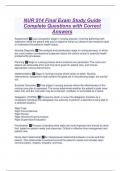NUR 514 Final Exam Study Guide
Complete Questions with Correct
Answers
Assessment ✅Cues recognition stage in nursing process, involving gathering both
subjective (what the patient tells you) & objective (what you observe and measure) data
to understand the patient's health status.
Nursing Diagnosis ✅The analysis and prioritization stage in nursing process, in which
the nurse makes a professional judgement about the client's actual or potential health
problems/life processes.
Planning ✅Stage in nursing process where solutions are generated. The nurse and
patient set achievable short and long-term goals for patient care, and choose
appropriate nursing interventions.
Implementation ✅Stage in nursing process where action is taken. Nursing
interventions, designed to help achieve the goals set in the planning stage, are carried
out.
Evaluate Outcomes ✅Final stage in nursing process where the effectiveness of the
nursing care plan is assessed. The nurse determines whether the patient's goals have
been met, and the care plan may be continued, modified, or terminated as a result.
Delegation (TCPDS) ✅Process by which a nurse (the delegator) transfers to a
competent individual (the delegatee) the authority to perform a selected nursing task in
a selected situation.
Right Task.
Right Circumstances.
Right Person.
Right Direction/Communication.
Right Supervision/Evaluation.
Prioritization ✅Process of deciding what tasks are most important and should be done
first, based on patient needs and resources. Critical in effective time management and
patient care.
Nurse-client relationship ✅An interpersonal relationship between a nurse and their
patient. This relationship is centered around the patient's needs and includes open
communication, respect, empathy, and trust.
, Pain Classifications & Types ✅Pain can be classified by its cause, source, intensity,
duration, and manner of expression. Common types include acute, chronic,
breakthrough, and cancer pain.
acute v chronic; breakthrough & cancer ✅Acute pain is sudden and short-term, chronic
pain lasts beyond normal healing time. Breakthrough pain is a temporary flare-up of
moderate to severe pain that occurs even when the patient is taking around-the-clock
medication for persistent pain. Cancer pain can be acute or chronic, depending on the
stage and spread of the disease.
Assessment: PQRSTU ✅Acronym used for assessing pain: Provocation/Palliation
(what brings it on/what makes it better); Quality/Quantity (how it feels/how intense);
Region/Radiation (where is it/does it spread); Severity (scale of 0-10); Timing
(onset/duration/frequency); Understanding (why do you think its happening).
Treatment & Management ✅Pain management involves pharmacologic (medications)
and non-pharmacologic (physical therapy, cognitive behavioral therapy, etc.)
treatments. It includes understanding the route of administration, educating patients,
monitoring for adverse effects, and evaluating effectiveness.
Chain of infection: 6 links ✅Describes the way an infection spreads. Includes infectious
agent (pathogen), reservoir (where pathogen lives), portal of exit (way for pathogen to
leave reservoir), mode of transmission (how pathogen gets to new host), portal of entry
(how pathogen enters new host), and susceptible host.
Pathogens ✅Organisms that cause disease, including bacteria, viruses, fungi, and
parasites. These are the first link in the chain of infection.
Hospital Acquired Infections (HAI) ✅Infections that patients get while receiving
treatment for medical or surgical conditions. Common types include urinary tract
infections, surgical site infections, bloodstream infections, and pneumonia.
Clinical manifestations-Local and systemic infections ✅Local infections affect only one
area of the body, causing redness, warmth, swelling, and pain. Systemic infections
affect the entire body, causing fever, fatigue, confusion, and other symptoms.
Nursing management & interventions ✅For infections, these include identifying the
infection, initiating appropriate treatments (like antibiotics), implementing infection
control measures (like hand hygiene and use of personal protective equipment), and
monitoring the patient's response to treatment.
Asepsis: hand hygiene, medical & surgical asepsis ✅Asepsis involves all activities to
prevent infection or break the chain of infection. Hand hygiene is the most important
measure. Medical asepsis (clean technique) includes procedures to reduce the number




